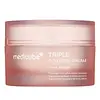What's inside
What's inside
 Key Ingredients
Key Ingredients

 Benefits
Benefits

 Concerns
Concerns

 Ingredients Side-by-side
Ingredients Side-by-side

Water
Skin ConditioningGlycerin
HumectantDipropylene Glycol
HumectantCetearyl Alcohol
EmollientCyclopentasiloxane
EmollientCaprylic/Capric Triglyceride
MaskingTriethylhexanoin
MaskingHydrogenated Polydecene
Emollient1,2-Hexanediol
Skin ConditioningNiacinamide
SmoothingHydrogenated Poly(C6-14 Olefin)
EmollientCyclohexasiloxane
EmollientGlyceryl Stearate Se
EmulsifyingDioscorea Japonica Root Extract
Skin ConditioningAesculus Hippocastanum Extract
AntioxidantLaminaria Japonica Extract
Skin ProtectingEclipta Prostrata Leaf Extract
Skin ConditioningCollagen Extract
Skin ConditioningHydrogenated Lecithin
EmulsifyingArgania Spinosa Kernel Oil
EmollientSodium Hyaluronate
HumectantCetearyl Olivate
C12-16 Alcohols
EmollientDimethicone
EmollientGlyceryl Stearate
EmollientPEG-100 Stearate
Microcrystalline Cellulose
AbsorbentCetearyl Glucoside
EmulsifyingSorbitan Olivate
EmulsifyingFructose
HumectantHydroxyethyl Acrylate/Sodium Acryloyldimethyl Taurate Copolymer
Emulsion StabilisingButylene Glycol
HumectantSqualane
EmollientPalmitic Acid
EmollientBetaine
HumectantCellulose Gum
Emulsion StabilisingHydrolyzed Corn Starch
HumectantPolysorbate 60
EmulsifyingEthylhexylglycerin
Skin ConditioningAdenosine
Skin ConditioningHydrogenated Polyisobutene
EmollientBeta-Glucan
Skin ConditioningAlcohol
AntimicrobialDisodium EDTA
Isononyl Isononanoate
EmollientPolyglyceryl-10 Stearate
Skin ConditioningSorbitan Isostearate
EmulsifyingSucrose
HumectantStearic Acid
CleansingButyrospermum Parkii Butter
Skin ConditioningPolyglyceryl-2 Dipolyhydroxystearate
Skin ConditioningFructooligosaccharides
HumectantInulin Lauryl Carbamate
Emulsion StabilisingHydrolyzed Hyaluronic Acid
HumectantCitric Acid
BufferingDisodium Stearoyl Glutamate
CleansingCollagen
MoisturisingHydrolyzed Elastin
EmollientHyaluronic Acid
HumectantTocopherol
AntioxidantLeuconostoc/Radish Root Ferment Filtrate
AntimicrobialParfum
MaskingPotassium Sorbate
PreservativeLinalool
PerfumingBenzyl Salicylate
PerfumingLimonene
PerfumingHydroxycitronellal
PerfumingWater, Glycerin, Dipropylene Glycol, Cetearyl Alcohol, Cyclopentasiloxane, Caprylic/Capric Triglyceride, Triethylhexanoin, Hydrogenated Polydecene, 1,2-Hexanediol, Niacinamide, Hydrogenated Poly(C6-14 Olefin), Cyclohexasiloxane, Glyceryl Stearate Se, Dioscorea Japonica Root Extract, Aesculus Hippocastanum Extract, Laminaria Japonica Extract, Eclipta Prostrata Leaf Extract, Collagen Extract, Hydrogenated Lecithin, Argania Spinosa Kernel Oil, Sodium Hyaluronate, Cetearyl Olivate, C12-16 Alcohols, Dimethicone, Glyceryl Stearate, PEG-100 Stearate, Microcrystalline Cellulose, Cetearyl Glucoside, Sorbitan Olivate, Fructose, Hydroxyethyl Acrylate/Sodium Acryloyldimethyl Taurate Copolymer, Butylene Glycol, Squalane, Palmitic Acid, Betaine, Cellulose Gum, Hydrolyzed Corn Starch, Polysorbate 60, Ethylhexylglycerin, Adenosine, Hydrogenated Polyisobutene, Beta-Glucan, Alcohol, Disodium EDTA, Isononyl Isononanoate, Polyglyceryl-10 Stearate, Sorbitan Isostearate, Sucrose, Stearic Acid, Butyrospermum Parkii Butter, Polyglyceryl-2 Dipolyhydroxystearate, Fructooligosaccharides, Inulin Lauryl Carbamate, Hydrolyzed Hyaluronic Acid, Citric Acid, Disodium Stearoyl Glutamate, Collagen, Hydrolyzed Elastin, Hyaluronic Acid, Tocopherol, Leuconostoc/Radish Root Ferment Filtrate, Parfum, Potassium Sorbate, Linalool, Benzyl Salicylate, Limonene, Hydroxycitronellal
 Reviews
Reviews

Ingredients Explained
These ingredients are found in both products.
Ingredients higher up in an ingredient list are typically present in a larger amount.
Collagen is the most abundant type of structural protein found in your body. It is an effective skin moisturizer.
There is no conclusive proof that collagen is used by skin when applied topically. However, it is a great humectant that hydrates skin. Hydrated skin is associated with increased elasticity and a decrease in the appearance of wrinkles. It is also essential for maintaining a healthy skin barrier.
Biologically, collagen is responsible for keeping skin firm and youthful. Collagen is comprised mostly of glycine, proline, and hydroxypoline. These are amino acids.
Collagen will not increase sun sensitivity, but you should always wear sunscreen during the day.
Learn more about hydrolyzed collagen here.
Learn more about CollagenEthylhexylglycerin (we can't pronounce this either) is commonly used as a preservative and skin softener. It is derived from glyceryl.
You might see Ethylhexylglycerin often paired with other preservatives such as phenoxyethanol. Ethylhexylglycerin has been found to increase the effectiveness of these other preservatives.
Glycerin is already naturally found in your skin. It helps moisturize and protect your skin.
A study from 2016 found glycerin to be more effective as a humectant than AHAs and hyaluronic acid.
As a humectant, it helps the skin stay hydrated by pulling moisture to your skin. The low molecular weight of glycerin allows it to pull moisture into the deeper layers of your skin.
Hydrated skin improves your skin barrier; Your skin barrier helps protect against irritants and bacteria.
Glycerin has also been found to have antimicrobial and antiviral properties. Due to these properties, glycerin is often used in wound and burn treatments.
In cosmetics, glycerin is usually derived from plants such as soybean or palm. However, it can also be sourced from animals, such as tallow or animal fat.
This ingredient is organic, colorless, odorless, and non-toxic.
Glycerin is the name for this ingredient in American English. British English uses Glycerol/Glycerine.
Learn more about GlycerinSodium Hyaluronate is hyaluronic acid's salt form. It is commonly derived from the sodium salt of hyaluronic acid.
Like hyaluronic acid, it is great at holding water and acts as a humectant. This makes it a great skin hydrating ingredient.
Sodium Hyaluronate is naturally occurring in our bodies and is mostly found in eye fluid and joints.
These are some other common types of Hyaluronic Acid:
Learn more about Sodium HyaluronateTocopherol (also known as Vitamin E) is a common antioxidant used to help protect the skin from free-radicals and strengthen the skin barrier. It's also fat soluble - this means our skin is great at absorbing it.
Vitamin E also helps keep your natural skin lipids healthy. Your lipid skin barrier naturally consists of lipids, ceramides, and fatty acids. Vitamin E offers extra protection for your skin’s lipid barrier, keeping your skin healthy and nourished.
Another benefit is a bit of UV protection. Vitamin E helps reduce the damage caused by UVB rays. (It should not replace your sunscreen). Combining it with Vitamin C can decrease sunburned cells and hyperpigmentation after UV exposure.
You might have noticed Vitamin E + C often paired together. This is because it is great at stabilizing Vitamin C. Using the two together helps increase the effectiveness of both ingredients.
There are often claims that Vitamin E can reduce/prevent scarring, but these claims haven't been confirmed by scientific research.
Learn more about TocopherolWater. It's the most common cosmetic ingredient of all. You'll usually see it at the top of ingredient lists, meaning that it makes up the largest part of the product.
So why is it so popular? Water most often acts as a solvent - this means that it helps dissolve other ingredients into the formulation.
You'll also recognize water as that liquid we all need to stay alive. If you see this, drink a glass of water. Stay hydrated!
Learn more about Water